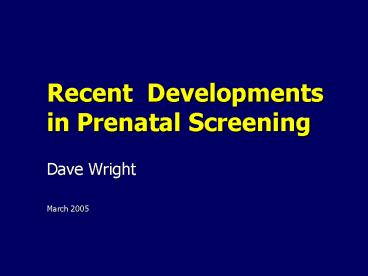Recent Developments in Prenatal Screening - PowerPoint PPT Presentation
1 / 19
Title:
Recent Developments in Prenatal Screening
Description:
Diagnostic Tests for Chromasomal Abnormalities. Chorionic Villus Sampling (CVS) Amniocentesis ... Nuchal Translucency. Stage 3: Second Trimester ... – PowerPoint PPT presentation
Number of Views:500
Avg rating:3.0/5.0
Title: Recent Developments in Prenatal Screening
1
Recent Developments in Prenatal Screening
- Dave Wright
- March 2005
2
Diagnostic Tests for Chromasomal Abnormalities
- Chorionic Villus Sampling (CVS)
- Amniocentesis
- These invasive tests increase the risk of
miscarriage. - If they were applied on a population basis to
500,000 pregnancies, they would lead to about
5,000 miscarriages in unaffected pregnancies. - More than 5 miscarriages for every Down syndrome
pregnancy.
3
Screening Tests
Ultrasound image data maternal serum
measurements
Bayes Theorem
Risk Pr Affected Maternal Age Markers
High Risk Offer CVS or Amniocentesis (About 5
are classified as high risk 25,000 invasive
tests and 250 miscarriages)
Low Risk
Reassurance
4
Biases
- Results based on secondary data provided in the
SURUSS study of Wald et al (2003 and 2004) - Without the raw data, we cant explore the
effects of data cleaning that will cause biases
in assessment of screening performance - These biases are important
- There is a need for further prospective studies
5
Some Common Protocols(detection rate fixed at
85)
Assuming a population of 500,000 pregnancies
screened.
Proportion of unaffected pregnancies classified
as high risk
Note parameters from Wald et al (2003) with
refinements of Wald et al (2004) in brackets.
6
Wald et al (2003)
- The integrated test offers the most effective and
safe method of screening.
7
Repeated MeasuresWright and Bradbury (2005)
PAPP-A2 denotes first and second trimester
measurements of PAPP-A.
8
Why were repeated measures protocols overlooked?
- Widely held misconceptions
- Best combination combination of best
- A measurement, such as PAPP-A in the second
trimester, that has no discriminatory value on
its own is of no value in combination with other
markers - High within class correlations are a sign of
redundancy
9
- Best combination combination of best
- A measurement, such as PAPP-A in the second
trimester, that has no discriminatory value on
its own is of no value in combination with other
markers - High within class correlations are a sign of
redundancy
10
Problems with integrated tests
- No assessment of risk in the first trimester
- Inefficient
11
Sequential ScreeningWright et al. (2004)
12
Sequential Screening
Detection rate fixed at 85
13
A Repeated Measures Sequential Strategy
Disposition of unaffected pregnancies
10 Weeks NT PAPP-A uE3
14 to 20 weeks PAPP-A uE3
14
Disposition of affected pregnancies
10 Weeks NT PAPP-A uE3
14 to 20 weeks PAPP-A uE3
15
Problems with NT
- Insufficient resources to measure NT in all
pregnancies
16
Stage 1 Biochemical Tests
A three stage sequential screening policy (Wright
et al, in press)
Risk 1 in b
Screen negative
Stage 2 Nuchal Translucency
Risk 1 in c1
Risk 1 in c2
Screen negative
Most of the benefits of the full integrated
version of the test can be achieved with 70 of
pregnancies screened negative in the first stage.
Screen positive
Stage 3 Second Trimester
Risk 1 in d
Risk lt 1 in d
Screen negative
Screen positive
17
Illustration
Disposition of unaffected pregnancies
Screen negative
Screen positive
18
Illustration
Disposition of affected pregnancies
19
Concluding remarks
- Contingent sequential screening is being used in
centres in Canada, the US and in the UK - Trials with repeated measures are being planned































